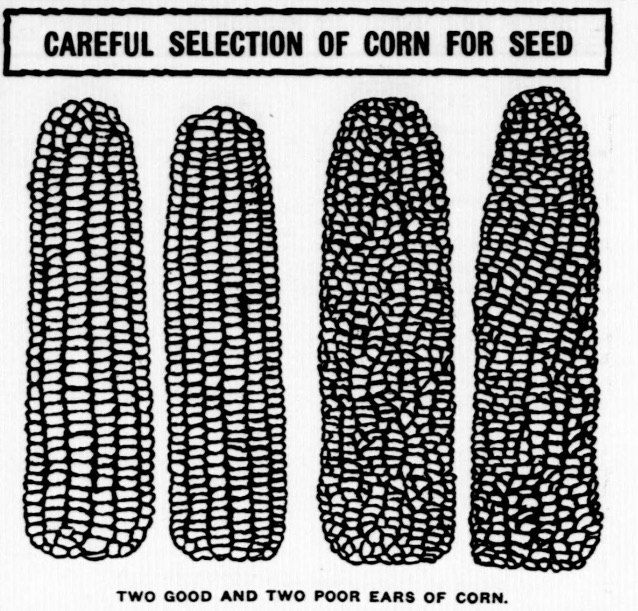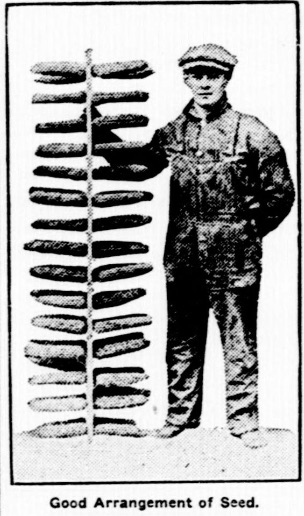
The article below, originally published in 1916, gives sound advice on selecting the best ears of corn for next year’s seed.

Careful Selection of Corn for Seed
The quality and quantity of next year’s corn crop will depend very largely upon the selection of seed – not merely the picking out of good looking ears, but upon the time, place and manner in which the selection is made.
If we wait until just before planting time next spring and then run through the corn crib and pick out what looks to be likely seed, we are taking chances of about eight to one against a full crop.
The time to select seed corn is in the fall after the grain is thoroughly ripe, and the selection should e made in the field. This method enables one to know exactly the kind of stalk which produced the ear and to avoid those stalks which, although they may have borne one good ear, indicate by their general appearance that they would not reproduce a perfect stand next season.
Seed corn selection is one of the most important details of growing the crop. It must be undertaken in a systematic manner, because slipshod and uncertain methods will only result in disappointment and failure.
Really seed corn should be raised on specially prepared ground from pedigreed seed, and this work should have been undertaken at planting time last spring.
When the corn is thoroughly ripe in the field the selection should be made by taking a row at a time and picking only those ears which come up to a certain standard fixed beforehand.
In the selection of the standard the farmer must make up his mind in advance whether he wants a large, coarse stalk with the ear high from the ground, or a smaller, stout stalk with the ear lower down.
If he desires a large ear with coarse grains or a medium sized ear with the grains compactly set, he must make his selections accordingly.
Right here, however, the selector is warned against a very common mistake – that is, picking ears of abnormal size or appearance. If he wants a large ear with coarse and loosely set grains he may find an occasional ear bearing these characteristics in a very marked degree, abnormally so in fact, but it would be a mistake to select such an ear because the tendency will be to increase variation, and when these variations run to excess they are pretty sure to produce undesirable qualities.
It would be just as great a mistake if the selector is looking for a medium sized ear with closely set grains to select an undersized ear with the abnormally sized grains, for the reason given above.
In the selection of seed of any kind, or in the breeding of animals, it is always wise to stick to the medium specimens having the characteristics desired, as better results will always follow such selections.
It is a good plan to select seed from stalks of stout, healthy growth which have made uniform progress during the season and that are well provided with leaves so as to provide plenty of fodder. It is important to observe the tassel of the stalk to see that it is strong, symmetrical and is well developed and free from any evidence of disease.

The stalks from which the ears are taken should be well rooted in the ground, upright, strong and vigorous, and any evidence of disease or abnormal growth should at once condemn them.
Only ears that are well silked and that are thoroughly covered with the husk from tip to tip should be selected. Here again it is a mistake to select ears bearing abnormally developed husks or husks that are too little developed.
If the ear contains an unusual amount of husk it is a sure sign of coarseness and will show up badly in next year’s crop.
The shank bearing the ear should be short and not over an inch or an inch and a quarter in diameter, and those ears pointing downward are the most desirable. These shed the rain and thus preserve the grain while those ears which stand upright, or nearly so, naturally catch moisture which trickles down into the grain and causes it to rot.
As to the number of rows and grains on the ear, these will vary with the variety, but in most standard varieties they run from 16 to 20, although they may run as high as 24 and still conform to standard.
If the number runs below 14 the ear should be discarded. The rows should run straight from butt to tip and those ears containing wavy rows or rows that become mixed at any point and lose their identity are not to be taken.
The seed ears should be stored in a rat proof room, not too cold nor warm enough to start germination in case of damp weather at any time during the winter. After the ears have dried a few days they should be husked and placed in racks, that they may cure uniformly. A very simple rack for this purpose can be made by driving wire nails into a stout board at intervals of about four inches and impaling the ears through the butts on the nails.
In this way the ears can be numbered and classified as desired.
Of course, in the spring, two or three weeks before planting time, the seed must be thoroughly tested for germination power. This is as important as selection and even more so, because it is useless to go to the trouble of preparing ground and planting seed unless you know it will grow.
Source: Tombstone epitaph. (Tombstone, Ariz.), 17 Dec. 1916.

